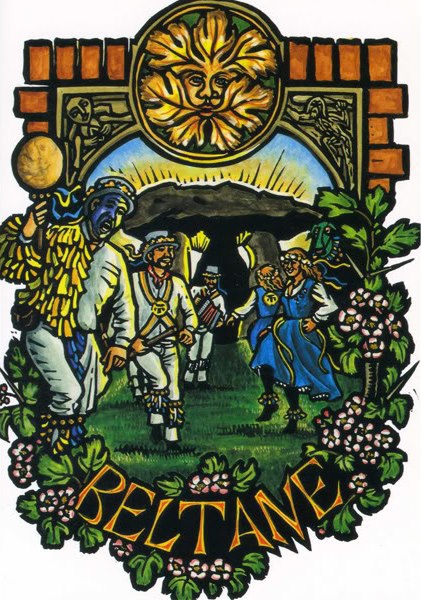Other Names: Beltane, May Eve, May Day, Samradh
Date: May 1 (Greater Sabbat/Cross Quarter)
Celebration of: The Lord and Lady consummate their relationship
Colors: White, Red and Pink
Symbols: Spring flowers (especially the rose).
Notes: Fire and fertility festival. Jumping over the balefire was said to insure protection. Dance around the May Pole. Ring bells to scare away bad spirits. Time for appreciation and affection for all that you have been given in your life. End of spring planting. A time for new beginnings, concepts and ideas.
BELTANE, (say Bell-Tane, or Beal-Tine) a Celtic Fire Festival literally meaning “Bright Fire” and refers to ritual extinguishing and rekindling of all fires. Fire means warmth, life, transformation. The Sun God comes to the Earth Goddess signaling good fortune and change. It is the first day of Summer and celebrates the half of the year dedicated to growth and fertility as manifested by the sac red union of the God and Goddess.
In this Sacred Marriage of the Goddess, as the land, with the young God as the force of life, the earth bursts forth with sprouting green and the tender colorful blossoms celebrating the fulfillment of their passion, calling us all to participate in their gladness. This is a celebration of life above all! Significant symbols include the bonfire as represented by a candle lit ritual using red candles, maypole with ribbons, and the hawthorn.
MAY DAY
by Mike Nichols
http://www.witchessabbats.com/
“Perhaps it’s just as well that you won’t be here …
to be offended by the sight of our May Day celebrations.”
—Lord Summerisle to Sgt. Howie from The Wicker Man
There are four great festivals of the Pagan Celtic year and the modern Witches’ calendar, as well. The two greatest of these are Halloween (the beginning of winter) and May Day (the beginning of summer). Being opposite each other on the wheel of the year, they separate the year into halves. Halloween (also called Samhain) is the Celtic New Year and is generally considered the more important of the two, though May Day runs a close second. Indeed, in some areas—notably Wales—it is considered “the great holiday”.
May Day ushers in the fifth month of the modern calendar year, the month of May. This month is named in honor of the Goddess Maia, originally a Greek mountain nymph, later identified as the most beautiful of the Seven Sisters, the Pleiades. By Zeus, she is also the mother of Hermes, God of magic. Maia’s parents were Atlas and Pleione, a sea nymph.
The old Celtic name for May Day is Beltane (in its most popular Anglicized form), which is derived from the Irish Gaelic Bealtaine or the Scottish Gaelic Bealtuinn, meaning “Bel-fire”, the fire of the Celtic God of Light (Bel, Beli, or Belinus). He, in turn, may be traced to the Middle Eastern God Baal.
Other names for May Day include: Cetsamhain (opposite Samhain), Walpurgisnacht (in Germany), and Roodmas (the medieval church’s name). This last came from church fathers who were hoping to shift the common people’s allegiance from the Maypole (Pagan lingam—symbol of life) to the Holy Rood (the cross—Roman instrument of death).
Incidentally, there is no historical justification for calling May 1 ‘Lady Day’. For hundreds of years, that title has been proper to the vernal equinox (approximately March 21), another holiday sacred to the Great Goddess. The nontraditional use of ‘Lady Day’ for May 1 is quite recent (since the early 1970s), and seems to be confined to America, where it has gained widespread acceptance among certain segments of the Craft population. This rather startling departure from tradition would seem to indicate an unfamiliarity with European calendar customs, as well as a lax attitude toward scholarship among too many Pagans. A simple glance at a dictionary (Webster’s 3rd or O.E.D.), encyclopedia (Benet’s), or standard mythology reference (Jobe’s Dictionary of Mythology, Folklore & Symbols) would confirm the correct date for Lady Day as the vernal equinox.
By Celtic reckoning, the actual Beltane celebration begins on sundown of the preceding day, April 30, because the Celts always figured their days from sundown to sundown. And sundown was the proper time for Druids to kindle the great Belfires on the tops of the nearest beacon hill (such as Tara Hill, Co. Meath, in Ireland). These “need-fires” had healing properties, and skyclad Witches would jump through the flames to ensure protection.
Sgt. Howie (shocked): "But they are naked!"
Lord Summerisle: "Naturally. It's much too dangerous to jump through the fire with your clothes on!"
—from The Wicker Man
Frequently, cattle would be driven between two such bonfires (oak wood was the favorite fuel for them) and, on the morrow, they would be taken to their summer pastures.
Other May Day customs include: walking the circuit of one’s property (“beating the bounds”), repairing fences and boundary markers, processions of chimney sweeps and milkmaids, archery tournaments, morris dances, sword dances, feasting, music, drinking, and maidens bathing their faces in the dew of May morning to retain their youthful beauty.
In the words of Witchcraft writers Janet and Stewart Farrar, the Beltane celebration was principally a time of “unashamed human sexuality and fertility”. Such associations include the obvious phallic symbolism of the Maypole and riding the hobbyhorse. Even a seemingly innocent children’s nursery rhyme “Ride a cock horse to Banburry Cross …” retains such memories. And the next line, “to see a fine Lady on a white horse”, is a reference to the annual ride of Lady Godiva through Coventry. Every year for nearly three centuries, a skyclad village maiden (elected “Queen of the May”) enacted this Pagan rite, until the Puritans put an end to the custom.
The Puritans, in fact, reacted with pious horror to most of the May Day rites, even making Maypoles illegal in 1644. They especially attempted to suppress the “greenwood marriages” of young men and women who spent the entire night in the forest, staying out to greet the May sunrise, and bringing back boughs of flowers and garlands to decorate the village the next morning. One angry Puritan wrote that men “doe use commonly to runne into woodes in the night time, amongst maidens, to set bowes, in so muche, as I have hearde of tenne maidens whiche went to set May, and nine of them came home with childe.” And another Puritan complained that, “Of forty, threescore or a hundred maids going to the wood over night, there have scarcely the third part of them returned home again undefiled.”
Long after the Christian form of marriage (with its insistence on sexual monogamy) had replaced the older Pagan handfasting, the rules of strict fidelity were always relaxed for the May Eve rites. Names such as Robin Hood, Maid Marion, and Little John played an important part in May Day folklore, often used as titles for the dramatis personae of the celebrations. And modern surnames such as Robinson, Hodson, Johnson, and Godkin may attest to some distant May Eve spent in the woods.
These wildwood antics have inspired writers such as Kipling:
Oh, do not tell the Priest our plight,
Or he would call it a sin;
But we have been out in the woods all night,
A-conjuring Summer in!
And Lerner and Lowe:
It's May! It's May!
The lusty month of May!…
Those dreary vows that ev'ryone takes,
Ev'ryone breaks.
Ev'ryone makes divine mistakes!
The lusty month of May!
It is certainly no accident that Queen Guinevere’s ‘abduction’ by Meliagrance occurs on May 1 when she and the court have gone a-Maying, or that the usually efficient Queen’s guard, on this occasion, rode unarmed.
Some of these customs seem virtually identical to the old Roman feast of flowers, the Floralia, three days of unrestrained sexuality that began at sundown April 28 and reached a crescendo on May 1.
There are other, even older, associations with May 1 in Celtic mythology. According to the ancient Irish Book of Invasions, the first settler of Ireland, Partholan, arrived on May 1, and it was on May 1 that the plague came that destroyed his people. Years later, the Milesians conquered the Tuatha De Danann on May Day. In Welsh myth, the perennial battle between Gwythur and Gwyn for the love of Creiddyled took place each May Day, and it was on May Eve that Teirnyon lost his colts and found Pryderi. May Eve was also the occasion of a fearful scream that was heard each year throughout Wales, one of the three curses of the Coranians lifted by the skill of Lludd and Llevelys.
By the way, due to various calendrical changes down through the centuries, the traditional date of Beltane is not the same as its astrological date. This date, like all astronomically determined dates, may vary by a day or two depending on the year. However, it may be calculated easily enough by determining the date on which the sun is at fifteen degrees Taurus (usually around May 5). British Witches often refer to this date as Old Beltane, and folklorists call it Beltane O.S. (Old Style). Some covens prefer to celebrate on the old date and, at the very least, it gives one options. If a coven is operating on ‘Pagan Standard Time’ and misses May 1 altogether, it can still throw a viable Beltane bash as long as it’s before May 5. This may also be a consideration for covens that need to organize activities around the weekend.
This date has long been considered a “power point” of the zodiac, and is symbolized by the Bull, one of the tetramorph figures featured on the tarot cards, the World and the Wheel of Fortune. (The other three symbols are the Lion, the Eagle, and the Spirit.) Astrologers know these four figures as the symbols of the four “fixed” signs of the zodiac (Taurus, Leo, Scorpio, and Aquarius), and these naturally align with the four Great Sabbats of Witchcraft. Christians have adopted the same iconography to represent the four Gospel writers.
But for most, it is May 1 that is the great holiday of flowers, Maypoles, and greenwood frivolity. It is no wonder that, as recently as 1977, Ian Anderson could pen the following lyrics for the band Jethro Tull:
For the May Day is the great day,
Sung along the old straight track.
And those who ancient lines did ley
Will heed this song that calls them back.
Document Copyright © 1983 – 2009 by Mike Nichols.
Text editing courtesy of Acorn Guild Press.
Website redesign by Bengalhome Internet Services, © 2009
Permission is given to re-publish this document only as long as no information is lost or changed, credit is given to the author, and it is provided or used without cost to others.
This notice represents an exception to the copyright notice found in theAcorn Guild Press edition of The Witches' Sabbats and applies only to the text as given above.
Other uses of this document must be approved in writing by Mike Nichols.


